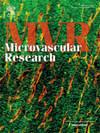血管紧张素1-7对自发性高血压大鼠肥厚心肌的电生理作用。
IF 2.7
4区 医学
Q2 PERIPHERAL VASCULAR DISEASE
引用次数: 0
摘要
本研究旨在探讨血管紧张素1-7 (Angiotensin 1-7, Ang1-7)对自发性高血压大鼠(SHR)高血压肥厚心肌电生理重构的影响。30只雄性SHR大鼠平均分为3组:SHR对照组(SHRC)生理盐水处理;Ang1-7组(shra)用Ang1-7[25 μg·(kg min)-1]和Ang1-7阻滞剂组(SHRB)用A779[72 μg·(kg min)-1]。Wistar-Kyoto (WKY)大鼠(n = 10)作为正常血压组。治疗时间为5 周。测量收缩压(SBP)和舒张压(DBP)。超声心动图评价心功能。采用微电极和膜片钳技术分离心室肌细胞,评价心肌电生理重构。与治疗前WKY大鼠比较,SHR组收缩压、舒张压均显著升高(P Na-T), SHR组收缩压、舒张压均显著降低(P 20、APD50、APD90), SHR组收缩压、舒张压均显著升高(P Na-T均显著高于SHR- c组(P 20、APD50、APD90)本文章由计算机程序翻译,如有差异,请以英文原文为准。
The electrophysiological effects of angiotensin 1–7 on hypertrophic myocardium in spontaneously hypertensive rats
This study aimed to explore the effects of Angiotensin 1–7 (Ang1–7) on electrophysiological remodeling of hypertensive hypertrophic myocardium in spontaneously hypertensive rats (SHR). Thirty male SHR rats were equally divided into three groups: SHR control group (SHR![]() C) treated with saline; Ang1–7 group (SHR-A) treated with Ang1–7[25 μg·(kg min)−1] and Ang1–7 blocker group (SHR
C) treated with saline; Ang1–7 group (SHR-A) treated with Ang1–7[25 μg·(kg min)−1] and Ang1–7 blocker group (SHR![]() B) treated with A779 [72 μg·(kg min)−1]. Wistar-Kyoto (WKY) rats (n = 10) were used as a normotensive group. The treatment period was 5 weeks. Systolic blood pressure (SBP) and diastolic blood pressure (DBP) were measured. Echocardiography was used to evaluate cardiac function. The ventricular myocytes were isolated for evaluation of electrophysiological remodeling of myocardium using microelectrode and patch clamp techniques. When compared with those in WKY rats before treatment, systolic and diastolic pressures were significantly higher in SHR (P < 0.01 and P < 0.001 respectively), left ventricular end-diastolic diameter (LVEDd) was significantly lower (P < 0.05), while diastolic interventricular septum thickness (IVSd), diastolic left ventricular posterior wall thickness (LVPWd) were significantly greater in SHR (P < 0.01). After 5 weeks of treatment, compared with SHR-C group, SBP, DBP, IVSd, LVPWd in SHR-A group were lower significantly (P < 0.05), while SBP in SHR-B group was significantly higher (P < 0.05). Compared with WKY group, the resting potential (RP), action potential amplitude (APA) and transient sodium current (INa-T) in SHR group were significantly lower (P < 0.05), and the action potential duration (APD20, APD50 and APD90) in SHR group was greater (P < 0.05). After Ang1–7 intervention, RP, APA and INa-T were significantly greater in SHR-A than those in SHR-C (P < 0.05), and APD in SHR-A significantly lower than that in SHR-C (P < 0.05). Taken together, these results demonstrated that Ang1–7 can not only decrease the blood pressure, but reverse the myocardial hypertrophy and electrophysiological remodeling as well in SHR rats.
B) treated with A779 [72 μg·(kg min)−1]. Wistar-Kyoto (WKY) rats (n = 10) were used as a normotensive group. The treatment period was 5 weeks. Systolic blood pressure (SBP) and diastolic blood pressure (DBP) were measured. Echocardiography was used to evaluate cardiac function. The ventricular myocytes were isolated for evaluation of electrophysiological remodeling of myocardium using microelectrode and patch clamp techniques. When compared with those in WKY rats before treatment, systolic and diastolic pressures were significantly higher in SHR (P < 0.01 and P < 0.001 respectively), left ventricular end-diastolic diameter (LVEDd) was significantly lower (P < 0.05), while diastolic interventricular septum thickness (IVSd), diastolic left ventricular posterior wall thickness (LVPWd) were significantly greater in SHR (P < 0.01). After 5 weeks of treatment, compared with SHR-C group, SBP, DBP, IVSd, LVPWd in SHR-A group were lower significantly (P < 0.05), while SBP in SHR-B group was significantly higher (P < 0.05). Compared with WKY group, the resting potential (RP), action potential amplitude (APA) and transient sodium current (INa-T) in SHR group were significantly lower (P < 0.05), and the action potential duration (APD20, APD50 and APD90) in SHR group was greater (P < 0.05). After Ang1–7 intervention, RP, APA and INa-T were significantly greater in SHR-A than those in SHR-C (P < 0.05), and APD in SHR-A significantly lower than that in SHR-C (P < 0.05). Taken together, these results demonstrated that Ang1–7 can not only decrease the blood pressure, but reverse the myocardial hypertrophy and electrophysiological remodeling as well in SHR rats.
求助全文
通过发布文献求助,成功后即可免费获取论文全文。
去求助
来源期刊

Microvascular research
医学-外周血管病
CiteScore
6.00
自引率
3.20%
发文量
158
审稿时长
43 days
期刊介绍:
Microvascular Research is dedicated to the dissemination of fundamental information related to the microvascular field. Full-length articles presenting the results of original research and brief communications are featured.
Research Areas include:
• Angiogenesis
• Biochemistry
• Bioengineering
• Biomathematics
• Biophysics
• Cancer
• Circulatory homeostasis
• Comparative physiology
• Drug delivery
• Neuropharmacology
• Microvascular pathology
• Rheology
• Tissue Engineering.
 求助内容:
求助内容: 应助结果提醒方式:
应助结果提醒方式:


